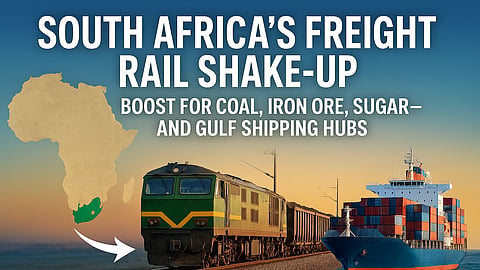South Africa’s Freight Rail Shake-Up: Boost for Coal, Iron Ore, Sugar - and Gulf Shipping Hubs
For years, South African exporters of coal, iron ore, sugar, and other bulk commodities have faced a frustrating reality: their goods often moved slower than their markets demanded.
Ageing locomotives, cable theft, and persistent maintenance backlogs at Transnet left producers scrambling for alternatives, often relying heavily on trucks clogging highways and inflating costs.
Now, with private firms being invited to operate trains on the state-owned freight rail network, exporters see a potential lifeline. The move could shift millions of tonnes from road to rail, promising smoother flows to ports like Richards Bay and Saldanha.
The Economic Ripples
For commodity exporters, rail is not just about moving goods—it’s about margins. Every delay at the pithead or port means lost opportunities in highly price-sensitive global markets.
Smart Ports: How Technology is Reshaping Global Cargo Logistics
Coal miners exporting to Asia, iron ore suppliers to China, and sugar producers serving Europe often find their competitiveness eroded not by global demand but by domestic logistics bottlenecks.
If private rail operators deliver on their promise of efficiency, exporters could see:
Lower logistics costs, helping them capture better margins.
Greater reliability, enabling longer-term supply contracts with overseas buyers.
Reduced congestion at ports, as steady rail arrivals replace the erratic surges caused by trucking convoys.
This matters for shipping too. Bulk carriers waiting at anchorage off Richards Bay or Durban often face costly demurrage. A more predictable inland logistics system translates into better vessel scheduling, lower costs, and improved trust among global buyers.
The Intermodal Connection
Modern logistics isn’t about rail alone—it’s about intermodal synergy. For South Africa’s exporters, the ideal chain is mine-to-rail-to-port-to-ship with minimal friction. Trucks will still play a role, especially in first- and last-mile delivery, but rail’s revival can unlock a smoother balance.
Consider sugar exporters in KwaZulu-Natal. With reliable rail access to Durban, they can load bulk shipments directly into containers bound for Europe, bypassing costly delays.
Iron ore miners in the Northern Cape can benefit from continuous rail flows to Saldanha, ensuring Capesize vessels aren’t idling offshore waiting for cargo.
The knock-on effect is not just commercial. Trucking-intensive freight has taken a toll on South Africa’s roads and communities—rising accidents, noise, and emissions. Rail offers a quieter, cleaner, safer alternative that resonates with ordinary South Africans living along those clogged routes.
A UAE Twist: Why the Gulf Cares
South Africa’s freight revival is not just a domestic story. It has clear implications for Gulf ports and logistics hubs, especially in the UAE.
Jebel Ali Port in Dubai and Khalifa Port in Abu Dhabi already serve as transshipment gateways for African commodities bound for Asia and Europe. More reliable South African exports could strengthen these routes, boosting cargo flows through UAE terminals. For instance:
Coal and iron ore shipped from Richards Bay or Saldanha often pass through Gulf waters en route to India or East Asia, creating opportunities for bunkering and value-added services in the UAE.
Sugar and agricultural exports can feed into Dubai’s position as a global food re-export hub, where commodities are processed, repackaged, and redirected to the Middle East and North Africa.
UAE-based shipping lines and logistics companies—already expanding into Africa—stand to benefit from South Africa’s improved supply reliability, which reduces risk in long-haul contracts.
In this sense, what happens on South African rail tracks could ripple all the way to Dubai warehouses and Fujairah refueling stations.
Lessons Beyond South Africa
South Africa’s experiment will be watched closely by other nations where state-run logistics systems struggle to keep pace with demand. For exporters, the promise is clear: when rail and shipping are connected seamlessly, local economies benefit, trade expands, and global buyers gain confidence in supply reliability.
The bigger story is that behind every tonne of coal or bag of sugar lies a farmer, a miner, a dockworker—ordinary people whose livelihoods depend on goods reaching ships on time.
If private rail participation succeeds, it won’t just be about tonnes and tariffs, but about restoring dignity to a supply chain that has long been under strain—one that ultimately links Africa’s mines and fields to the Gulf’s ports and the world beyond.
Read More: The Last Mile Continues to Remain a Challenge for Global 3PL Giants


